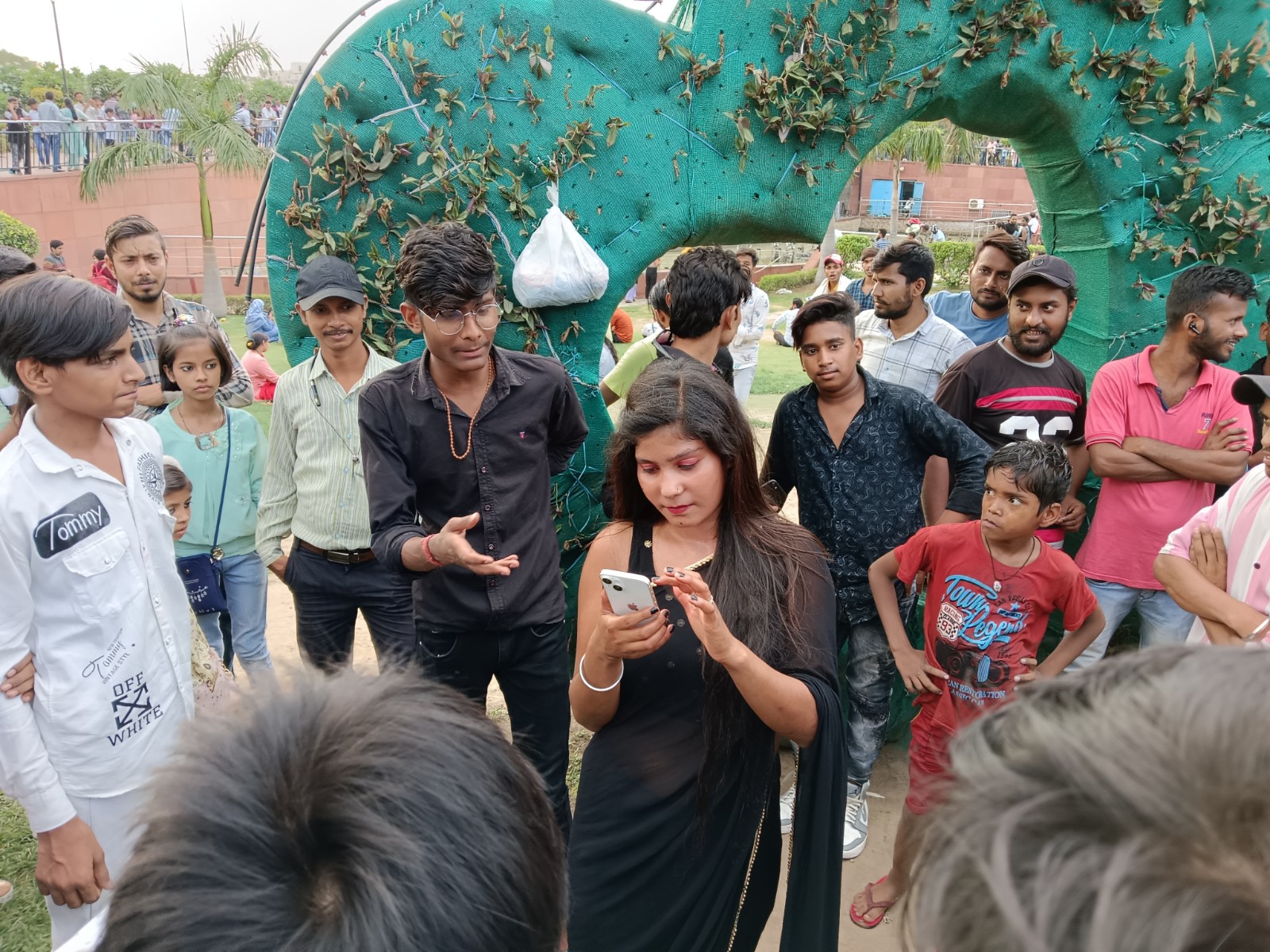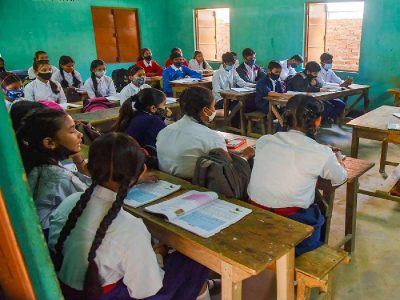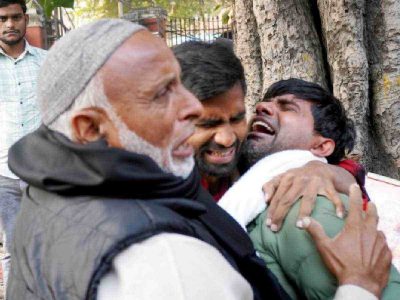A mobile camera, a good Delhi location, four friends, and a script that revolves around the sacrifices of mother: that is all it takes for 21-year-old Farzan Khan, a resident of Seelampur in Delhi, to follow his ‘passion’ for creating content.
Farzan, who owns a kirana (grocery) store, spends his weekdays thinking about his next shoot with his four partners. The script, he says, has to be around his mother, but in between, he also has to make trending videos for the algorithm. Every Sunday, he comes to Connaught Place’s Central Park for the shoot, and dissolves among hundreds of other content creators present in the park.
Delhi’s public spaces, especially Connaught Place’s Central Park, often become a hub of content creators coming from diverse backgrounds, many of whom took to Instagram and Youtube after the ban of the Chinese-owned app Tiktok in June 2020. The introduction of reels on Instagram in July 2020 and YouTube shorts in September 2020 opened the doors for the former Tiktok content creators, with many new faces emerging on the two platforms.
These content creators, many of whom are from low-income families, have a variety of content strategies. Some of them are pranksters, dancers, skit-makers, rappers and models while others are stuntmen and travel enthusiasts.
At one glance, Central Park on Sunday looks like a set for a movie shoot.
As the visitors spend their evening taking selfies, enjoying the fountain show and munching on snacks, hundreds of them also gather around these content creators, as many dismiss them as another ‘Tiktokiya thinking he is a movie star’.
Connaught Place’s location in the heart of Delhi and its picturesque surroundings serve as a perfect background for videos. The main attraction is Victorian-style buildings, along with Central Park’s frenzy that adds to the environment.
“It’s a very good location for videos because the background is lovely. But most importantly, we can also meet and collaborate with other content creators here. A beginner may get an opportunity to shoot with someone who is famous, and this makes it popular among us,” says Farhan Shaik, a content creator.
“The reason behind people coming to Connaught Place is that people here aren’t that bothered. They may gather around, but they really don’t care, and this makes the process easy,” he adds.
Coming from far-off places
While many of these content creators come from the outskirts of Delhi, there are some who visit the place from far-off towns of nearby states. Manish Jumper, whose videos usually feature him performing a flip, comes to Central Park from Ganaur in Haryana every Sunday to make videos.
“I come to Delhi to shoot at places like Central Park. I don’t see creating content as some side hobby. It is my profession and I look forward to it. My family is not financially strong and I am even supporting them with it,” said the 19-year-old.
He went viral after a schoolmate uploaded on Tiktok his video of performing a flip at a school function, and he has never looked back since. Now, he has lakhs of subscribers on YouTube and 39,000 followers on Instagram.
Apart from uploading videos of him performing flips, Jumper also does pranks. In one of the videos, Jumper makes a flip near a passerby and offers him a rose – as the camera zooms in to reactions of those around.
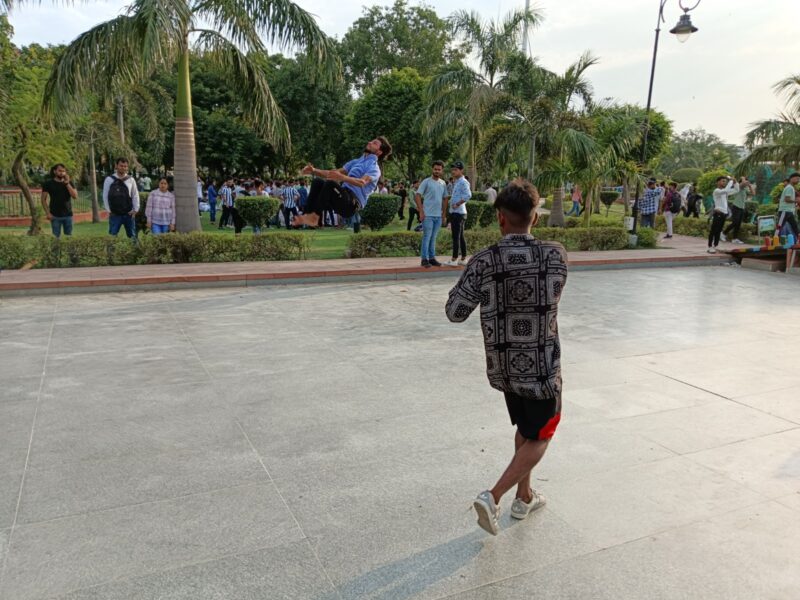
Like Manish, Sahil Mirza comes from Panipat in Haryana with his team of five.
“In Delhi, people know that we are doing pranks for social media. However, this is not the case with Panipat. There, people don’t consider it as a career. They tend to make fun of you if you are shooting a video for social media,” he says.
Mirza learnt about social media content when his friend, Ankur, became famous with time and started earning money. Although his friend started with Tiktok, Mirza said that he uploads only on Youtube and Instagram.
While creators at the Central Park were mostly in the age group of 17-22 years, there are also parents who manage social media accounts of their children.
Children superstars
Heena Malik, a resident of Saket, was in two minds when some people around her started uploading his four-year-old son Shaad Malik’s short videos on Youtube and Instagram. However, as he became famous with time, not only did she approve of it, but also encouraged him to make videos.
“In the beginning, I used to scold him for facing the camera and also whenever kids or adults made his videos and uploaded it on social media. But then I saw a lot of potential in him and realised that his talent at such a tender age needs recognition. I made an Instagram account last year just to upload his videos,” she says. She maintains that she will never appear in the videos, and only her son is a ‘star’.
Shaad, who is now six, has 8.6 lakh followers on Instagram. Heena informs that his previous account, which gained more than five lakh followers in just six months, was hacked.
“We have to be careful, you know. This happened here in Central Park. I gave my mobile to another creator to shoot a video and the next thing I knew was that I was logged out of my account,” she says discreetly.
The life of a mother of a social media star is not easy, Heena says, because there is constant bullying from extended family and neighbours.
“People make comments about me and him whenever they see me,” she says. “It gives me shivers even thinking about it. Such a small child should not make videos, they say. It is only the support from my husband that keeps me going.”
When this reporter visited the park, Heena was shooting a video with another child content creator Gudiya, who came all the way from Moradabad in Uttar Pradesh to meet Shaad as a fan, and the interaction sparked into a collaboration.
Gender bias
The crowd in the park majorly comprises men. Women social media influencers often face harassment from the crowd. So much so that many of them stop making videos at all. Some of them are in their teenage years, while others in their early twenties. Almost all of them have faced difficulties while making videos. Surprisingly, the harassment does not come only from the crowd, but also male content creators.
Archana Singh, 21, confidently struts along the lane adjacent to the fountains in the park as a friend takes her video. An aspiring actress and a model, Archana calls the style of her content “girl’s attitude”.
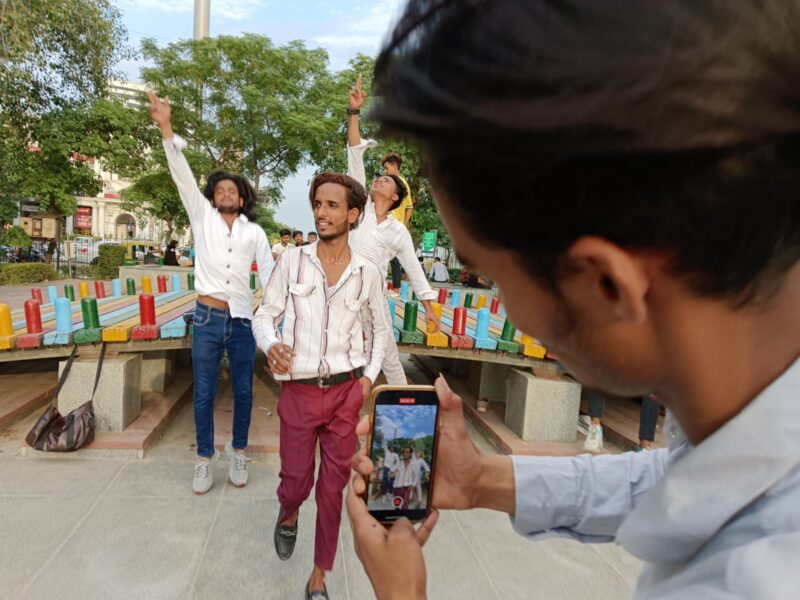
“If you are a woman, you will obviously have to hear comments,” Archana says matter-of-factly, “Whenever I perform in public for a video, a crowd gathers around and starts to hoot and pass comments. It gets extremely difficult for women who are new in this journey; some of them stop making content at all. The best thing you can do, I think, is ignore.”
Archana comes to the park from Janakpuri. In the beginning, her parents were reluctant to let her upload her videos on a social media. But as she progressed and started earning, they started to approve of it.
She laments about the condition of artists, especially women, in public spaces.
“No one respects us. If we make videos here, they brush us off as if we lack values. This is very wrong and I believe people should be encouraged to respect artists,” she says.
Archana has managed to have 75,000 followers on Instagram after starting her journey in 2022.
In the pinned post of her Instagram account, a video features three young girls kneeling before three young boys.
As Archana arrives on screen, the boys get scared and kneel down before Archana as the girls rush to Archana’s side. The Pashto song Hawa sun sun sun plays in the background.
Asked if she creates reels for financial reasons, she says “If you invest in your passion, you should not think about money. Of course, money is a big factor. But right now, I just want to focus on my dreams. I earn some money, but not enough to pay all the bills.”
India saw the rise of content creators from different marginalised sections of the society particularly after the introduction of the Jio internet in 2016. The emergence of short-form video-sharing platforms significantly contributed in magnifying the numbers.
As cheap internet and easy-to-use technology emerged in the country, even those who have been invisibilised started to claim online spaces. A transgender person, belonging to the traditional kinnar community, is famous among content creators in the park.
When Patriot asked the trans person about how she started, she carelessly said, “Hamara to kaam hai ye. Hum Hijre paida hue, hijron ne paala, aur bann gaye content creators” and refused to comment further.
She was begging with her friend in the blocks of Connaught Place. For those who did not give her money, she asked them to follow her on Instagram.
Different approach
Shehzan Sartaj, 17, a native of Uttar Pradesh who makes travel videos, spends his pocket money to visit places like Delhi, Kashmir, Uttarakhand, among others.
A former Tiktoker, he took to Instagram and Youtube when Tiktok was banned.
“I have had a passion for it since childhood. I have received many risks and bullying from the public but I continued,” says Sartaj.
Shehzan informs that he had thousands of followers on Tiktok, where he made skit videos, before he learnt about travel videos.
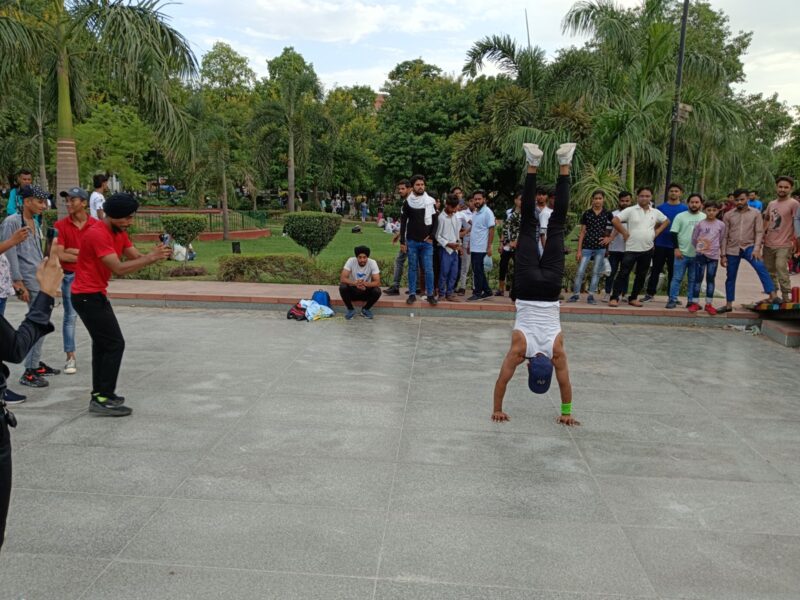
“There are two kinds of blogging,” he says confidently, “For example, there are those who give information about places and then there are those who just start the video and record their activities there – I belong to the latter.”
A lot of people in his neighbourhood, he says, used to bully him for his videos.
“’All he knows is how to say guys’, this is what they would say, but I never let my spirit down,” he says.
“This is my future. I want to be a businessman, and this is what keeps me going,” he adds.
He takes pride in his 1,300 subscribers on Youtube and remember his Tiktok days, where he had thousands of followers.
Like Shehzan, Manish also reminisces the ‘good old days’ of Tiktok, the app that took him to fame.
“I had thousands of followers on Tiktok. I had to start from zero after the app got banned. I tried many apps, and settled on Instagram and YouTube because they are there to stay,” he says.
Farzan echoes similar sentiments. “On Tiktok, we could upload anything and it would shoot up. There are a few guidelines that we have to follow on Instagram. Also, if you post anything that may contain abusive language, our account will be restricted or get banned. So, we have to be careful,” he says.
For Instagram, a certain kind of aesthetic has to be maintained, Farzan says, and he invests more time in editing and enhancing the quality of his videos – unlike Tiktok where he could upload anything.
Is it really ‘cringe’?
According to an article in The Print, content creators of the app Tiktok were thought to be “lower caste people” by certain sections of Indian society and have also been called “Shudras of internet”, thus creating caste divide in a supposedly democratic online space, with influencers coming from urban, upper-class backgrounds such as YouTuber CarryMinati having passed comments “Mithai ki dukaan pe 200 mein bik jaoge (you will be sold at a sweet shop for Rs 200)”.
These content creators, who were introduced to other video platforms through Tiktok, are often rendered “cringeworthy”.
Multiple accounts on Instagram regularly upload old videos by Tiktok content creators with the hashtag #Cringe and #ChapriIndia (chapri is a classist slur that means those who live in slums). Some of them sarcastically make videos about how they survived 2019 and early 2020, when the popularity of Tiktok was at its peak.
These ‘curatorial’ accounts became so popular among Instagram audiences that lifestyle magazine Vogue India “revealed” the identity of admins of Emo Bois Of India, a meme popular page that claims to introduce “popular culture” to urban elites, for the first time in a summit in March this year. In fact, a trend on Instagram by urban content creators is to replicate old Tiktok videos and its “cringeworthy” storyline – often exaggerating the “cringe” in them.
When Patriot asked about how former Tiktok content creators see this tendency of reducing their content to “cringe”, most of them were nonchalant and maintained “anyone who hustles, deserves success”.
“We make efforts to create content. It’s not that we are doing anything wrong. Some people do, but we [the group] don’t. What is the problem if people are liking it?” Farzan says.
Professor Suruchi Mazumdar, in her paper ‘Loving the enemy app: Resistance versus professionalism in ‘post-TikTok’ India’, calls the content created on Tiktok ‘vernacular creativity’.
She suggests that content creators, who learned to make videos and express themselves on the ‘low technology’ app Tiktok, do not just perform ‘self-taught practices’ but ‘movie direction’-like professional culture that remains central to India’s short video digital space.
Such professionalism, she observes, also united TikTok with other platforms in the post-ban digital space, despite differences.
While some of them are already earning, others have a good number of followers. There are also those who have just started. Farhan now uploads videos on his personal account when his “mentor” Farzan encouraged him.
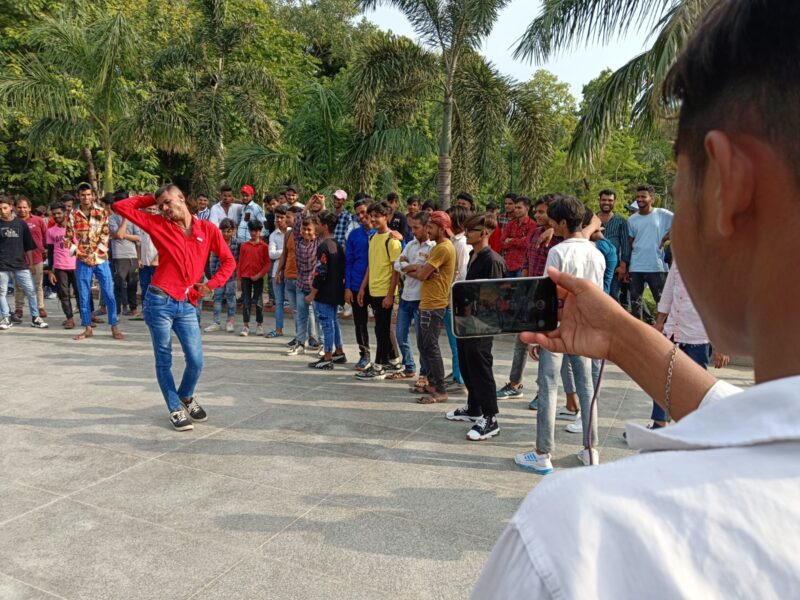
“He said that we must also have a platform where people get to know each of us individually. He is my mentor and I listen to whatever he has to say,” says Farhan.
With most of the Tiktok content creators joining Instagram and Youtube, and others starting their journey afresh on these apps, there are also those who miss the “boring and painful” days of Covid-19 lockdown.
“Tiktok was banned and I had nothing to do. It was not just that I had stopped earning, I also could not watch anything as it was the only app, I would spend my time on. However, things have changed now,” says Manish.

